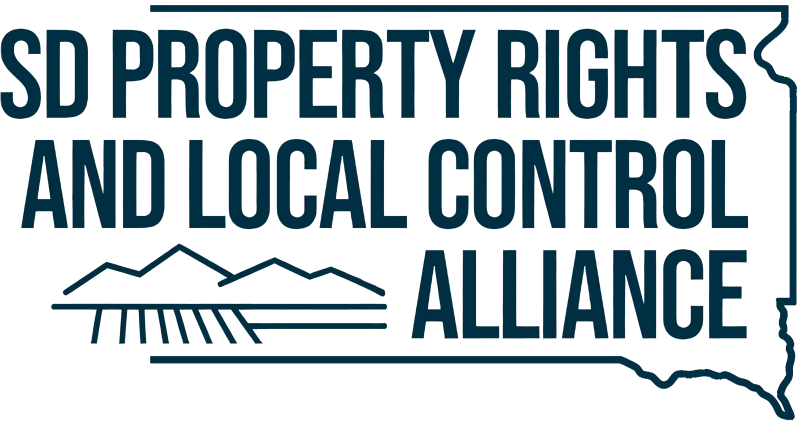Why is RL21 a bad bill?
There are many reasons why RL21 should never become law.
It is a violation of the South Dakota Constitution: RL21 violates the constitutional mandate prohibiting the Legislature from enacting private or special laws that regulate county and township affairs. The bill’s preemption of local land use, zoning, and building regulations undermines South Dakota’s 135-year-old tradition of established local control.
Furthermore, the South Dakota Constitution mandates, “No law shall cover more than one subject, which must be clearly stated in its title.” The title of RL21 encompasses three distinct and separate subjects, while the bill’s content incorporates several additional topics not reflected in its title.
RL21 erodes local control: The bill changes current law by mandating that transmission facility regulations be subject to Public Utilities Commission (PUC) orders, stripping local communities of their decision-making powers.
Restrictions on Fees: The bill limits the ability of local government to impose fees, including those crucial for emergency response, effectively shifting the financial burden of potential pipeline incidents onto taxpayers.
Inadequate Protection for Citizens: RL21, as passed, contains insufficient safeguards for citizens and property owners who would live in close proximity to the proposed pipeline. It totally fails to address the severe risk of possible catastrophic pipeline failures, which could endanger the lives and property of thousands of citizens.
Vague Terminology and PUC Handcuffing: Ambiguous language within the bill restricts the PUC’s discretionary powers, compromises the commission’s ability to make informed decisions for the citizens’ welfare, and invites potential litigation.
Important provision removed: A section was deleted that stated “Without such a finding by the commission, no route shall be designated which violates local land use, zoning or building rules, or regulations, or ordinances.” It is critical that this remains the law in South Dakota because it is central to local control. Right now, if the PUC doesn’t rule that a local ordinance or regulation is unreasonable, then the local regulation or ordinance stands. That law has worked successfully for 135 years in South Dakota, and there is no reason why it should be changed just so a private pipeline company with foreign investors wants to change the rules.
Did RL21 create a "Landowner Bill of Rights"?
RL21 Did not create a “Landowner Bill of Rights.” RL21’s so-called landowner protections fail to address eminent domain abuse—the critical issue—by facilitating easier land acquisition and use by private pipeline companies at the expense of South Dakotans’ inherent property rights.
This bill is actually a “Pipeline Company Bill of Rights.” Summit already agreed to a depth of 48” so that’s nothing new. If they would have said 72” that would have been a protection for landowners! And telling Summit to repair drain tile is not a concession. The law ALREADY protects us from personal damage to property. Thanks for nothing.
Didn’t Representative Will Mortenson say that South Dakota has the “strongest landowner protections in the Country”?
Hardly. Minnesota doesn’t allow the use of eminent domain for siting CO2 pipelines, period. Yet Summit was able to site 246 miles of Co2 pipeline. Texas (with its thousands of miles of pipelines) has a specific Landowner Bill of Rights that is far more thorough in protecting their citizens. Texas law does not allow condemning authorities to exercise eminent domain for tax revenue or economic development.
If RL21 becomes law, does that mean the pipeline company can start trenching?
No. Summit Carbon Solutions does not have a public route, or an application pending, or a permit from the PUC. However, that has not stopped them from lobbying to create a law that will grease the skids for their pipeline. Since 1975, landowners have placed their confidence in the PUC to perform its duties effectively, and since 1885, they have trusted counties to do the same. There is no reason to enact this as law.
RL21 protects citizens because it makes Summit Carbon Solutions plume study publicly available, right?
RL21 obscures the significant risks posed by inexperienced companies, such as Summit Carbon Solutions, with limited experience in the CO2 pipeline industry. When will Summit’s “plume studies” be made available? The single most important decision-making piece of information has been hidden from the public by Summit through this entire process.
The Public Utilities Commission (PUC) set a precedent for making such data public. During the PUC permitting process, Navigator shared plume modeling data, showing that a plume with a concentration of 40,000 parts per million (PPM)—a level immediately dangerous to health and human life—would travel at least 1,855 feet from an 8-inch line. For comparison, a 24-inch line can carry 15 times more hazardous CO2 than an 8-inch line. Therefore, it’s imperative that this modeling be included from the outset with the application, made available to the public, and distributed to all affected counties and first responders immediately.
The lack of transparency in providing this information to local and county officials and emergency responders should raise serious concerns over who is building this pipeline, and what they have to hide.
RL21 keeps the public in the dark about the risk that South Dakotans face from a company that has never built a CO2 pipeline, certainly not one of this scale, and that by their own admission presents a national security risk.
What does a CO2 Pipeline Rupture Look Like?
Below is a playlist of several videos demonstrating what a CO2 pipeline rupture looks like and the effects it has on the surrounding environment.
What Do State Legislators Say About RL21?
Below is a playlist of several videos from the House Floor debate on SB201 from the 2024 legislative session.
